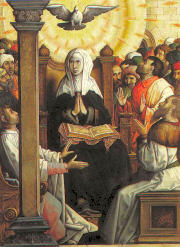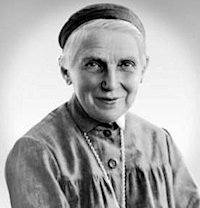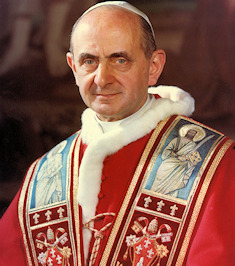Easter: May 29th
Saturday of the Seventh Week of Easter
Other Commemorations: St. Ursula (Giulia) Ledóchowska
» Enjoy our Liturgical Seasons series of e-books!
"Peter turned and saw the disciple Jesus loved following them the one who had leaned on his breast at the supper and had said to him, 'Lord, who is it that will betray you? Seeing him, Peter said to Jesus, 'What about him, Lord?' Jesus answered, 'If I want him to stay behind, till I come, what does it matter to you? You are to follow me.'"
It was a big role for such small men, "simple men, without learning", as they are described in Acts 4:13...They all belonged to the same social class. They were neither poor nor rich; they were craftsmen earning an honest living, men whose fortune lay in their boats and nets. There was no intellectual among them, in the sense attached to the word in the Israel of that time...Christ's power must have been great indeed to make these men participants in the great adventure. So true is it that, for the service of God, high qualities of intellect count less than those of the heart and the soul: will-power, loyalty, courage. — Henri Daniel-Rops
Before the reform of the General Roman Calendar today was the feast of St. Mary Magdalen de' Pazzi which is now celebrated on May 25.
Eve of Pentecost
 Today is the solemn eve of the great feast of Pentecost. A vigil always implies preparation, a time for cleansing and adorning the soul before the feast. Two themes occupy our attention: a) baptism; b) the graces of Pentecost. In spirit we stand at the font of our baptism to stir up the graces that we once received. There we can meditate upon the pointed words that St. Augustine addressed to a class of neophytes. "Today with the greatest joy Mother Church will give birth to you through holy baptism. By the most sacred sign of the Cross she conceived you in her womb, there she nourishes you and joyfully brings you, her joyful children, to the day of birth. In the holy bath of baptism true light is restored to you.
Today is the solemn eve of the great feast of Pentecost. A vigil always implies preparation, a time for cleansing and adorning the soul before the feast. Two themes occupy our attention: a) baptism; b) the graces of Pentecost. In spirit we stand at the font of our baptism to stir up the graces that we once received. There we can meditate upon the pointed words that St. Augustine addressed to a class of neophytes. "Today with the greatest joy Mother Church will give birth to you through holy baptism. By the most sacred sign of the Cross she conceived you in her womb, there she nourishes you and joyfully brings you, her joyful children, to the day of birth. In the holy bath of baptism true light is restored to you.
"Mother Church is not affected by the punishment inflicted upon Eve who must give birth to her children in pain and sorrow, nor do her children come into the world weeping as those of Eve; you are born with a cry of joy. . . . All the mystery-laden rites that have been performed over you (during your catechumenate) and are still being performed by the ministry of ordained priests, such as the exorcisms, prayers, spiritual songs (psalms), insufflations, penitential garb, bowing the head, prostrations, even the very fear that you experience-all these things are food which should enliven you in the womb so that when reborn in baptism, Mother Church may present you as joyful children to Christ.
"You have already received the Creed; this Creed is your mother's protection against the serpent's venom. In John the apostle's Apocalypse it is written that the dragon stood before the woman who was about to bring forth, that when she had brought forth he might devour her son (12:5). You all know that the dragon is the devil; also, that the woman represents the Virgin Mary, who a virgin herself, gave birth to our Virgin Head. She, moreover, is a type of holy Church; for as Mary remained a virgin in giving birth to a Son, so the Church remains virginal although constantly giving birth to new members.
"You have vowed to renounce the devil, and in this vow that has been recorded not by men but by God and His angels, you have declared: I do renounce him. Renounce him not merely with words, but in your conduct too; not only with the sound of the voice, but in the acts of daily life; not by the speech of lips alone, but with the loud cry of action. Remember that you have joined battle with a wily, skilled, and inveterate enemy; once you have renounced him, never let him discover his own handiwork in you lest he claim the right to drag you away into servitude. For you shall be detected and brought to light, O Christian, whenever your deeds contradict your vow." — The Church's Year of Grace, Pius Parsch
Pope St. Paul VI
Pope Paul VI (Giovanni Battista Montini) was born on 26 September 1897 at Concesio (Brescia), in Italy. On 29 May 1920 he was ordained to the priesthood. In 1924 he began his service to the Supreme Pontiffs, Pius XI and Pius XII, and at the same time exercised his priestly ministry among university students.
Nominated as the Substitute of the Secretariat of State he worked during the Second World War to find shelter for persecuted Jews and refugees. He was later designated Pro-Secretary of State for the General Affairs of the Church, also because of which he knew and encountered many of the proponents of the ecumenical movement. Appointed as Archbishop of Milan, he worked with great care for the diocese.
In 1958, he was elevated to the dignity of a Cardinal of the Holy Roman Church by Pope Saint John XXIII, and following his death was elected on 21 June 1963 to the See of Peter. He immediately continued the work begun by his predecessors, in particular, he brought the Second Vatican Council to its completion and he began many initiatives that showed his solicitude for the Church and for the contemporary world. Among these initiatives we ought to recall his voyages as a pilgrim, undertaken as an apostolic service which served both as a preparation for the unity of Christians and in asserting the importance of fundamental human rights.
Furthermore, he exercised his Supreme Magisterium favouring peace, promoting the progress of peoples and the inculturation of the faith, as well as the liturgical reform, approving Rites and prayers at once in line with tradition and with adaptation for a new age. By his authority he promulgated the Calendar, the Missal, the Liturgy of the Hours, the Pontifical and nearly all of the Ritual for the Roman Rite with the purpose of promoting the active participation of the faithful in the Liturgy. At the same time he saw to it that papal celebrations should take on a more simple form.
At Castel Gandolfo on 6 August 1978, he gave his spirit back to God and, according to his wishes, he was buried just as he had lived, in a humble manner.
—from the Vatican Website
Highlights and Things to Do:
- Read more about Pope Paul VI:
- See the Vatican's collection of Paul VI's work during his papacy.
St. Mother Orsola (Giulia) Ledóchowska
 "If only I knew how to love, to burn and consume oneself in love" - so the 24 year old Giulia Ledóchowska wrote before taking religious vows, novice in the Ursuline convent of Krakow. On the day of the religious profession she took the name 'Maria Ursula of Jesus', and the words stated above became the guide lines of her entire life. In her mothers' family (of Swiss nationality and of the dynasty of the Salis), as well as in her fathers' (an old Polish family) there were many politicians, military men, ecclesiastics and consecrated people, who were involved in the history of Europe and of the Church. She was raised in a family of numerous brothers and sisters where affectionate and disciplined love was dominant. The first three children, including M. Ursula, chose the consecrated life: Maria Teresa (beatified in 1975) founded the future 'Society of S. Peter Claver' and the younger brother Vladimiro became the general Preposito of the Jesuits.
"If only I knew how to love, to burn and consume oneself in love" - so the 24 year old Giulia Ledóchowska wrote before taking religious vows, novice in the Ursuline convent of Krakow. On the day of the religious profession she took the name 'Maria Ursula of Jesus', and the words stated above became the guide lines of her entire life. In her mothers' family (of Swiss nationality and of the dynasty of the Salis), as well as in her fathers' (an old Polish family) there were many politicians, military men, ecclesiastics and consecrated people, who were involved in the history of Europe and of the Church. She was raised in a family of numerous brothers and sisters where affectionate and disciplined love was dominant. The first three children, including M. Ursula, chose the consecrated life: Maria Teresa (beatified in 1975) founded the future 'Society of S. Peter Claver' and the younger brother Vladimiro became the general Preposito of the Jesuits.
M. Ursula lived in the convent at Krakow for 21 years. Her love for the Lord, her educational talent and sensibility towards the needs of youngsters in the changing social, political and moral conditions of those times put her at the centre of attention. When women earned the right to study in Universities, she succeeded in organising the first boarding-house in Poland for female students where they not only found a safe place to live and study, but also received a solid religious preparation. This passion, together with the blessing of Pope Pio X, gave her the strength to move into the heart of Russia which was hostile towards the Church. When, in civilian dress, she left with another Sister for Petersburg (where religious life was prohibited) she did not know that she was headed towards an unknown destination and that the Holy Spirit would lead her upon roads she had not foreseen.
In Petersburg the Mother with the steadily growing community of nuns (soon established as an autonomous structure of the Ursulines) lived secretly, and even though, under constant surveillance by the secret police, they brought forward an intense educational and religious project which was also directed towards the encouragement of relationships between Polish and Russians.
When war broke out starts in 1914, M. Ursula had to leave Russia. She headed for Stockholm and during her Scandinavian travels (Sweden, Denmark, Norway) her activity concentrated not only on education, but also on the life of the local Church, on giving aid to the war victims and on ecumenical work. The house where she lived with her nuns became a point of reference for people of different political and religious orientation. Her strong love for her country was the same as her tolerance towards 'diversity' and towards others. Once asked to speak of her political orientation, she promptly answered 'My policy is love'.
In 1920 M. Ursula, her sisters and a vast number of orphan children of immigrants returned to Poland. The Apostolic Headquarters transforms its autonomous convent of the 'Ursulines of the Sacred Agonising Heart of Jesus' The spirituality of the congregation is concentrated on the contemplation of the salvific love of Christ and participation in His mission by means of educational projects and service to others, particularly to the suffering, the lonely and the abandoned who were searching for the meaning of life. M. Ursula educated her sisters to love God above everything else and to find God in every human being and in all Creation. She gave a particularly credible testimony to the personal bond with Christ and to being an efficient instrument of both Evangelical and educational influence by means of her smile and serenity of soul. Her humility and capacity to live the ordinary everyday routine as a privileged road towards holiness made her a clear example of this life style.
The congregation developed quickly. The communities of the Ursuline nuns in Poland and on the eastern frontiers of the country which were poor, multinational and multi-confessional were established. In 1928 the Generalate was established in Rome along with a boarding-house for girls who were economically less well-off, in order to give them the possibility to come into contact with the spiritual and religious richness of the heart of the Church and of European civilisation. The Sisters began to work in the poor suburbs of Rome. In 1930 the nuns accompanied girls in search of work and established themselves in France. Wherever possible M.Ursula founded educational and instructional work centres. She sent the nuns to Catechise and to work in the poor parts of town. She wrote books and articles for children and youngsters.
She initiated and sustained ecclesiastical organisations for children (Eucharistic Movement), for youngsters and for women. She actively participated in the life of the Church and State thus receiving great acknowledgement and decorations from both the State and the Church. When her laborious and not easy life came to an end in Rome on May 29, 1939, people said of her: "She died a saint."
John Paul II beatified M. Ursula on June 20, 1983 in Poznan and canonized her on May 18, 2003 at Rome.
—© Libreria Editrice Vaticana
Highlights and Things to Do:
- Read more about St. Urszula Ledóchowska:
- See the Sanctuary of St. Ursula.






